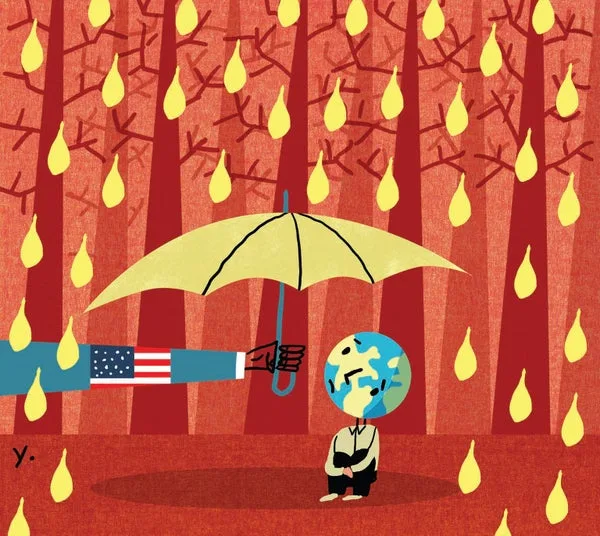January 1, 2024
4 min read
The wealthy countries that are most responsible for greenhouse gas pollution must compensate the poorer nations that bear the greatest burden

James Yang
The U.S. got a powerful reminder last summer that pollution doesn’t care about borders. Smoke from wildfires blazing across Canada billowed hundreds of miles south, painting skies from New York City to Chicago and beyond a hazy orange and damaging air quality to the point that health officials were warning people not to go outside.
Greenhouse gas pollution is similar—not governed by borders, warming the planet indiscriminately and damaging the climate on an extremely broad scale. In this era of climate crisis, in which decades’ worth of carbon pollution from rich nations is magnifying natural disasters, poorer countries are paying some of the steepest costs.
It’s time to start compensating these countries. The United Nations recently decided to address this issue through its yearly climate gathering, the Conference of the Parties, or COP. At COP27 in November 2022, world leaders agreed to create a fund for loss and damages for climate disasters, and attendees at 2023’s COP28 planned to further the conversation. But climate diplomacy can be slow, and it will be tough to make these reparations a reality.
Nevertheless, the U.S. and its carbon-spewing counterparts must pursue climate reparations to right the wrongs of carbon pollution and help lower-income nations weather the climate emergency.
Reparations, broadly understood, are payments offered to make up for loss or damage, and they can be a touchy subject for a range of legal and psychological reasons. They are just one of several funding mechanisms through which we can try to ease the unequal burden of climate change, including some that focus specifically on climate mitigation or adaptation. But whatever the term, the science is clear on the necessity of these payments.
Scientists estimate that worldwide, humans produced nearly 2.5 quadrillion kilograms of carbon dioxide between 1851 and 2021. Analysis after analysis has shown that over time the U.S. has produced by far the most heat-trapping gases—17 percent of the global total. This astronomical amount equals the combined emissions produced by more than 20 developed nations, including Germany, Japan and Australia. In comparison, climate emissions from 47 of the least developed countries add up to just 6 percent of the total. China ranks second among individual countries, at 12 percent of total emissions, but it began industrializing much later than the U.S. Because of China’s large population, the country’s per capita emissions are slightly more than half of those of Australia, Canada or the U.S.
Although industrial countries occasionally pledge to solve these problems, they still bicker about how much climate disruption they are willing to permit, and they haven’t put their money where their promises are. Wealthy nations have pledged to fund projects to mitigate climate change such as expanding clean energy, as well as adaptation projects such as building seawalls. They’ve promised $100 billion a year for these kinds of projects, but the funding hasn’t materialized. And because industrial countries have opposed decarbonization for so long, mitigation and adaptation are not enough.
People are already dying from the consequences of carbon pollution that developed nations generated while amassing their wealth. For example, last September a hurricanelike storm from the Mediterranean drenched Libya with one year’s worth of water in a single day. Two dams collapsed, and at least 4,000 people died, although the true toll might be closer to 10,000. Scientists have determined that such a disaster—a one-in-600-year flood—is 50 times more likely today than it was when the planet was 1.2 degrees Celsius cooler.
“By delaying the discussion, we have accepted that people can die and that enormous harm can happen at the global level,” says Joyeeta Gupta, a sustainability scientist at the University of Amsterdam.
Scientists are also clear on the role this pollution plays in exacerbating disasters, both in general and for individual cases. Hundreds of studies have sought to quantify the contribution of climate change to specific disasters. The majority of such studies on heat waves show that these events are becoming more likely or more severe as climate upheaval continues. Around half of the studies on heavy rainfall and flooding or on drought reach that same conclusion.
As the climate crisis worsens these kinds of events, their toll becomes ever steeper. In 2022 Earth experienced about 40 billion-dollar disasters, including Hurricane Ian in the southeastern U.S., devastating floods in Pakistan and drought in eastern Africa. The U.S. bears more of the responsibility for these crises and boasts more resources for responding to them, whereas countries across the developing world lack the wealth, insurance infrastructure and government programs needed to recover from disaster. Meanwhile the slower-moving calamity of sea-level rise is eating away the tiny homelands of small island nations, which might soon begin facing the steep costs of involuntary relocation.
We call on those who have become rich at the expense of a less livable world to prioritize the needs of developing countries and others bearing the brunt of the climate crisis. At home and abroad, there’s no time to wait. The science is clear: the industrial world is responsible. The least we can do is pay for the damage we’ve done.


